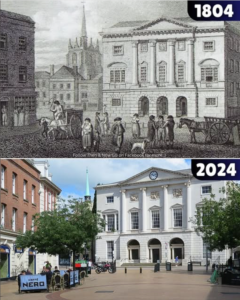Shire Hall in Chelmsford stands as one of the most iconic historical landmarks in Essex. With its classical architectural style and rich history, this Grade II-listed building has been a significant part of the town’s cultural and administrative heritage for over two centuries.
The History of Shire Hall
Origins and Construction
Shire Hall was built in the late 18th century, with its construction completed in 1791. Designed by the architect John Johnson, the building was commissioned to serve as a courthouse and an administrative center for Essex. Its grand opening in July 1791 marked the beginning of its role as a judicial and civic institution.
Role in the Legal System
For many years, Shire Hall functioned as a key judicial center, housing courts and legal proceedings. The building witnessed numerous trials and legal events, shaping the history of law and order in the region. Even as modern legal institutions developed, Shire Hall retained its historical significance in the legal landscape of Chelmsford.

Architectural Features
Classical Design and Façade
Shire Hall is a prime example of classical architecture, featuring a grand Portland stone façade that has been well-preserved over the centuries. The symmetrical design, large columns, and intricate detailing reflect the elegance and craftsmanship of the Georgian era. The structure remains a striking feature in the heart of Chelmsford, attracting architecture enthusiasts and historians alike.
Interior Layout and Modifications
The building originally included a large courtroom, offices, and meeting rooms. Over the years, various modifications and restorations have taken place to preserve its original charm while accommodating new uses. Although it no longer serves as a courthouse, Shire Hall continues to be an essential landmark in the town.

Shire Hall Today
Cultural and Civic Importance
Today, Shire Hall remains a symbol of Chelmsford’s historical and cultural identity. While its original function as a courthouse has changed, the building is still used for events, exhibitions, and other public activities. The hall’s significance extends beyond its architectural beauty, serving as a link between the past and present.
Preservation and Future Plans
Efforts to maintain and restore Shire Hall have been ongoing to ensure that it remains a part of Chelmsford’s heritage. Preservation initiatives focus on protecting its architectural integrity while finding new ways to utilize the space for community engagement. Future plans may include adaptive reuse projects to keep the building relevant for modern purposes.
Conclusion
Shire Hall, Chelmsford, is a testament to the town’s rich history and architectural legacy. From its origins as a courthouse to its current role as a cultural landmark, the building continues to capture the interest of residents and visitors alike. As restoration and preservation efforts continue, Shire Hall is set to remain a cherished part of Chelmsford’s historical landscape for generations to come.
